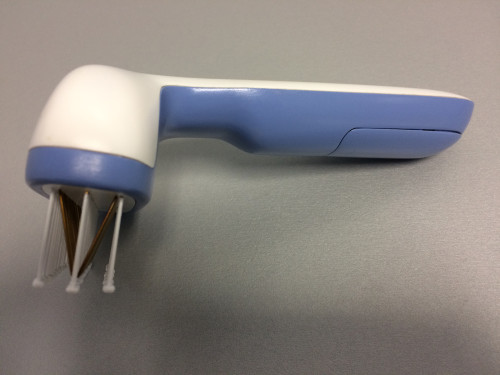
Nit picker: the cold plasma lice killer. (Courtesy: Fraunhofer IST)
By Hamish Johnston
Do your children have head lice again? Now you don’t have to comb their hair until your arm goes numb or cover their head with goop. Instead, you can zap them away using a plasma. I’m not suggesting that you put your child’s head into ionized gas that’s hotter than the Sun – it turns out that a “cold atmospheric pressure plasma” will do the trick.
That’s the claim of researchers at the Fraunhofer Institute for Surface Engineering and Thin Films in Göttingen, Germany. The team has created the above prototype, which creates a plasma using a high-voltage generator that sends short pulses to the teeth of the comb. The pulses ionize air molecules surrounding the teeth, but they are so short that the resulting plasma does not heat up. The charged ions and electrons in the plasma make short work of killing lice and their eggs, but are harmless to humans – at least according to Wolfgang Viöl and colleagues, who will be unveiling their device later this month at the MEDICA trade fair in Düsseldorf.
Once you have junior’s lice problem sorted out, you might want to launch them on a career path towards being an astronaut. Make sure that they pursue a bachelor’s degree in engineering, biological science, physical sciences or mathematics. And according to the latest from NASA, an advanced degree is desirable.
Today’s children will miss out on the next round of recruitment, which opens on 14 December and runs for two months – but you might be in with a chance. According to the Daily Telegraph, “The next class of astronauts can expect to fly on any of four different US vessels during their careers: the International Space Station, two commercial crew spacecraft currently in development by US companies, and NASA’s Orion deep-space exploration vehicle.” The lucky astronauts will be announced in mid-2017 after what I’m sure will be a gruelling selection process.
Does the Nit Picker work against bed bugs and their eggs?
I’m wondering about hooking this gadget up to my Roomba to plasmo-nize any fleas or flea eggs the cats and dogs bring in on the carpet?
Trackback: Zapping head lice and a job that is out of this world – MyPhysNet